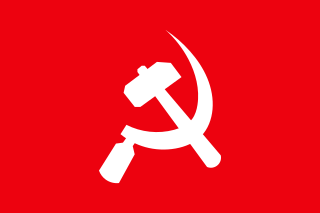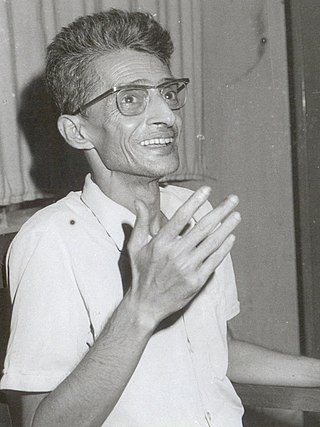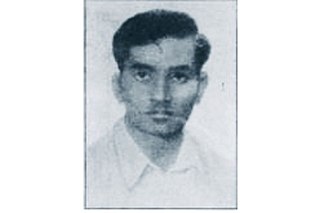
The Communist Party of India (Marxist–Leninist) (CPI (ML)) was an Indian communist party formed by the All India Coordination Committee of Communist Revolutionaries (AICCCR) at a congress in Calcutta in 1969. The foundation of the party was declared by Kanu Sanyal at a mass meeting in Calcutta on 22 April, Vladimir Lenin's birthday. Later the CPI(ML) party splintered into several Naxalite groups.
Communist Party of India (Marxist–Leninist) Naxalbari was an underground Maoist political party in India. The party had its roots partially in the Maoist Unity Centre, CPI (ML) and partially in the group of Rauf in Andhra Pradesh.
Andhra Pradesh Coordination Committee of Communist Revolutionaries (APCCCR) was a leftist split from the Communist Party of India (Marxist) in the Indian state of Andhra Pradesh. The leader of the group was T. Nagi Reddy, who was a member of the legislative assembly in AP at the time. Other leading figures were D.V. Rao, Chandra Pulla Reddy and Kolla Venkaiah. Both Reddy and Rao had been active in the Telangana armed struggle, and Rao had formulated the "Andhra Thesis" of the Communist Party of India (CPI).

Charu Majumdar, popularly known as CM, was a Communist leader from India, and founder and General Secretary of the Communist Party of India (Marxist-Leninist). Born into a progressive landlord family in Siliguri in 1918, he became a Communist during the Indian Independence Movement, and later formed the militant Naxalite cause. During this period, he authored the historic accounts of the 1967 Naxalbari uprising. His writings, particularly the Historic Eight Documents, have become part of the ideology which guides the insurgencies.
Adibhatla Kailasam was an Indian communist leader. Kailasam was one of the original leaders of the Srikakulam peasant uprising. Kailasam came from a landlord family of Kaarivalasa village in Srikakulam, Andhra Pradesh. He joined the Communist Party of India (Marxist-Leninist) and he was elected to its central committee at the party congress in 1970.
Kanu Sanyal was an Indian communist politician. In 1967, he was one of the main leaders of the Naxalbari uprising and in 1969 he was one of the founding leaders of Communist Party of India (Marxist-Leninist). Sanyal committed suicide on 23 March 2010.
The Maoist Communist Centre (MCC) was one of the largest two armed Maoist groups in India, and fused with the other, the People's War Group in September 2004, to form the Communist Party of India (Maoist).
Mamidi Appalasuri was an Indian communist leader. Appalasuri was one of the leaders of the tribal uprising in Srikakulam. When the Andhra Pradesh Committee of Communist Revolutionaries was expelled from the All India Coordination Committee of Communist Revolutionaries in 1968, Appalasuri remained with the AICCCR led by Charu Majumdar. In 1969 Appalasuri was one of four Central Committee members of the new Communist Party of India (Marxist-Leninist) from Andhra Pradesh.
Kondapalli Seetharamaiah was a senior communist leader and Maoist organizer in India.
Donkada Bhuvan Mohan Patnaik, also known as D. B. M. Patnaik or simply DBM, was an Indian lawyer, politician and communist leader. He was from Bhagimpeta in Srikakulam district.
Vempatapu Satyanarayana (Satyam) was a schoolteacher, member of several Indian Communist organizations, and a leader of the Srikakulam peasant uprising of 1967, along with Adibhatla Kailasam and Subbarao Panigrahi. They had started the "land to tiller" movement in Andhra Pradesh, which later spread to South Odisha.

The Naxalite–Maoist insurgency is an ongoing conflict between Maoist groups known as Naxalites or Naxals and the Indian government. The influence zone of the Naxalites is called the red corridor, which has been steadily declining in terms of geographical coverage and number of violent incidents, and in 2021 it was confined to the 25 "most affected" locations, accounting for 85% of Left Wing Extremism (LWE) violence, and 70 "total affected" districts across 10 states in two coal-rich, remote, forested hilly clusters in and around the Dandakaranya-Chhattisgarh-Odisha region and the tri-junction area of Jharkhand-Bihar and-West Bengal. The Naxalites have frequently targeted police and government workers in what they say is a fight for improved land rights and more jobs for neglected agricultural labourers and the poor.
Jangal Santhal, also known as Jangal Santal from Hatighisa village, Darjeeling district in north West Bengal, was one of the founders of the Naxalite movement.
The Radical Students Union (RSU) was a frontal organization of the Communist Party of India (Maoist), a Naxalite group. Founded in 1974, it became defunct after 2005. In 2011 there were indications of plans to revive the organization.
Satyanarayan Singh was an Indian communist politician. Singh was one of the early leaders of the Communist Party of India (Marxist-Leninist), being its secretary in Bihar.

Lal Sena was an organised armed militia of CPIML Liberation in northeastern India, across the terrains of central Bihar, north-west of today's Jharkhand, and a few districts of eastern Uttar Pradesh. It was formed mainly by lower caste peasantry and landless labourers.

Naxalbari uprising was an armed peasant revolt in 1967 in the Naxalbari block of Siliguri subdivision in Darjeeling district, West Bengal, India. It was mainly led by tribals and the radical communist leaders of Bengal and further developed into the Communist Party of India (Marxist–Leninist) in 1969. The armed struggle became an inspiration to the Naxalite movement which rapidly spread from West Bengal to other states of India creating division within the CPI(M) - India's primary communist party.
Central Organising Committee, Communist Party of India (Marxist–Leninist) was a communist party in India, one of the main splinter factions of the original Communist Party of India (Marxist–Leninist). COC, CPI(ML) occupied a middle position between the pro-Charu Majumdar group led by Mahadev Mukherjee and the anti-Majumdar group led by Satyanarayan Singh. Failing to articulate a common ideological position, COC, CPI(ML) soon suffered internal divisions and splits. Two of the splinter groups of COC, CPI(ML) in Andhra Pradesh are predecessors of the present-day Communist Party of India (Maoist).

Jagdish Mahto was a naxal leader who led the 1970 Bhojpur uprising in the landlord-dominated Bhojpur region of Bihar. He was a member of the Communist Party of India (Marxist–Leninist), an organisation which was leading the Naxalite insurgency against the Government of India. He also fought against the upper-caste landlords for the cause of lower-caste people. Mahto, also called Master Saheb, was a member of the Bihar State Committee of CPI(M–L) and one of the founding leaders of the party in Bhojpur.
Subbarao Panigrahi was a Telugu revolutionary poet and leader of Srikakulam peasant uprising.





